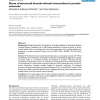148 search results - page 8 / 30 » The evolutionary capacity of protein structures |
BMCBI
2006
13 years 7 months ago
2006
Background: When accurate models for the divergent evolution of protein sequences are integrated with complementary biological information, such as folded protein structures, anal...
BMCBI
2007
13 years 7 months ago
2007
Background: Protein interactions are thought to be largely mediated by interactions between structural domains. Databases such as iPfam relate interactions in protein structures t...
BMCBI
2005
13 years 7 months ago
2005
Background: Secondary structure is used in hierarchical classification of protein structures, identification of protein features, such as helix caps and loops, for fold recognitio...
BMCBI
2010
13 years 7 months ago
2010
Background: Detection of common evolutionary origin (homology) is a primary means of inferring protein structure and function. At present, comparison of protein families represent...
BMCBI
2007
13 years 7 months ago
2007
Background: For many metalloproteins, sequence motifs characteristic of metal-binding sites have not been found or are so short that they would not be expected to be metal-specifi...

